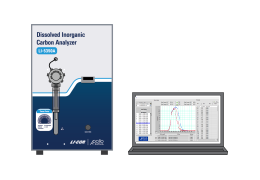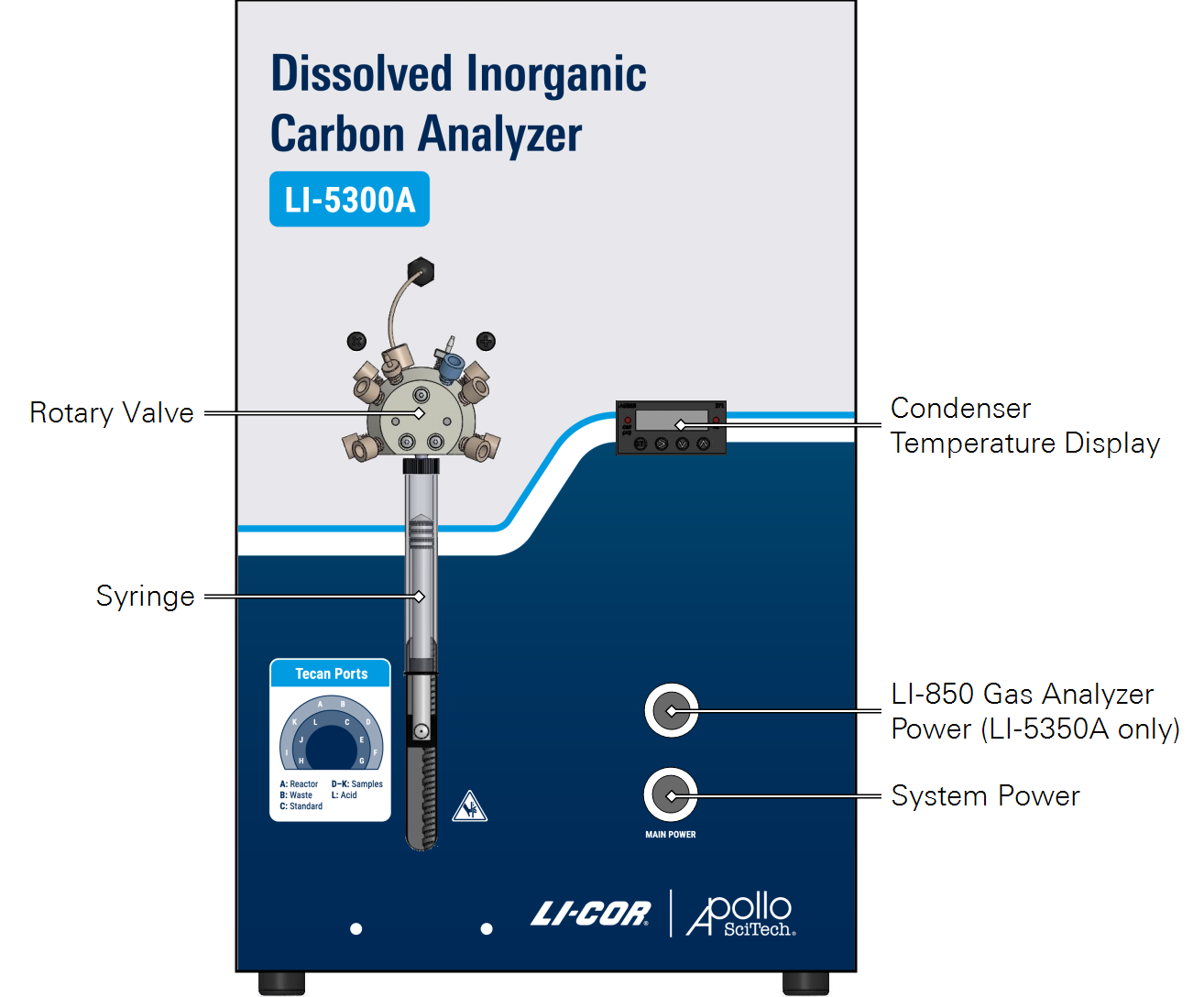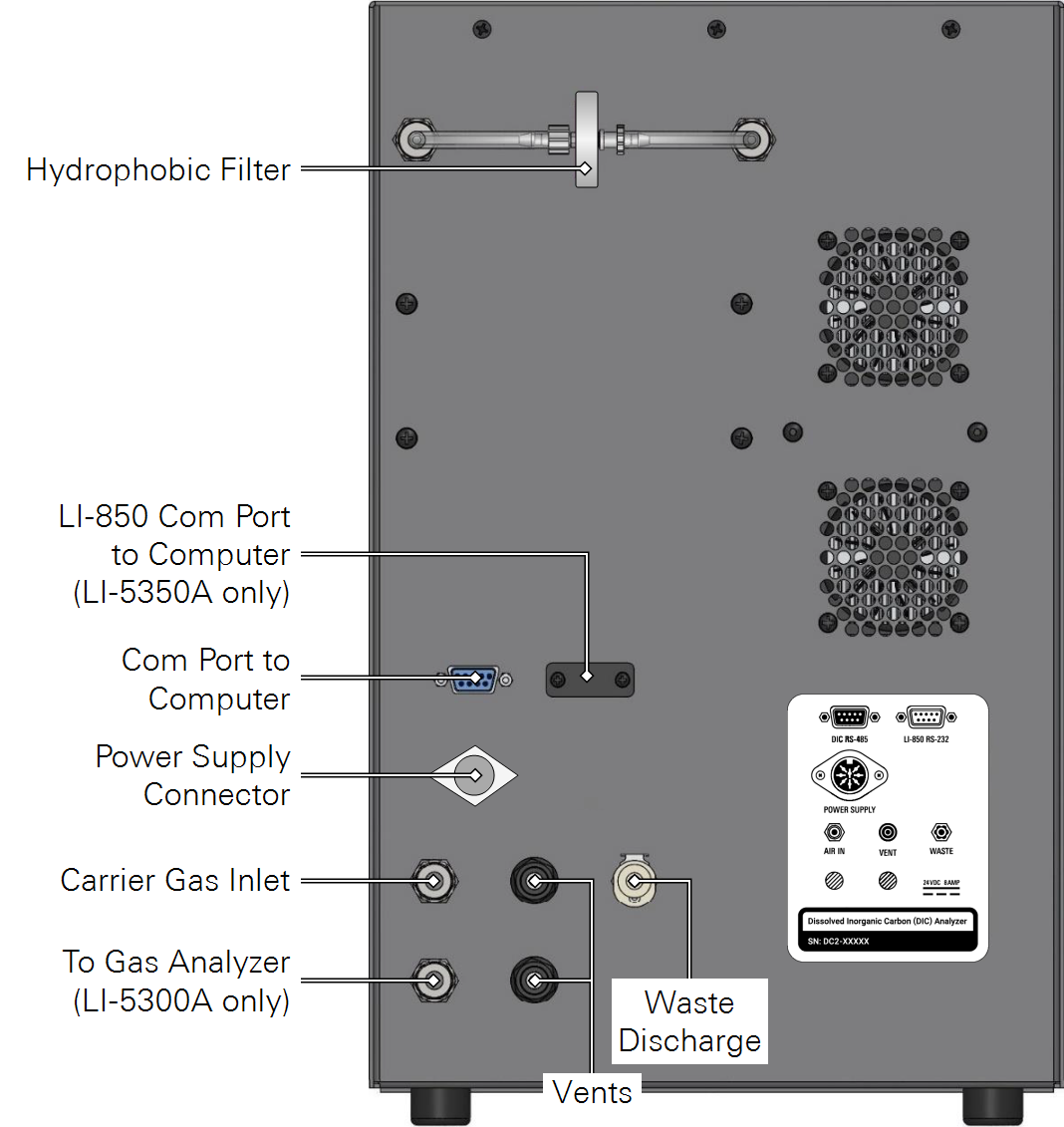Introduction to the LI-53x0A DIC systems
Welcome, and thank you for your purchase of a Dissolved Inorganic Carbon (DIC) measurement system. If you have just taken delivery of your package, check the packing list to be sure you received everything you ordered.
Two models of DIC system are described. LI-5300A features an external LI-7815 CO2/H2O Trace Gas Analyzer. LI-5350A features an internal LI-850 CO2/H2O Gas Analyzer. Although the models differ in important ways, operations are largely the same, and any differences are clearly distinguished throughout the document.

What's what
Each DIC system includes a DIC module, gas analyzer, and computer. For the LI-5350A, the gas analyzer is built into the DIC module.
The DIC module
The DIC module features the valves, tubing, digital syringe pump, mass flow controller, gas-stripping reactor, and a cooling condenser system.
Rotary valve
A 12-port digitally controlled valve for the acid, samples, standard, and waste water. See Connecting tubes for acid, standards, samples, and waste for port assignments.
Syringe
The mechanically actuated, computer-controlled syringe pump delivers a precise quantity of acid, standard solution, or sample for measurement. The LI-5300A uses a 5 mL syringe. The LI-5350A uses a 2.5 mL syringe.
Condenser temperature display
Displays the condenser temperature. Although it has buttons, do not attempt to change the setting here. Instead, the settings is configured in the software.
LI-850 Gas Analyzer power button
Used to power on or off the built-in LI-850 gas analyzer (LI-5350A model only).
System power
When connected to a power supply, the power button turns the DIC system on or off. When you are done with measurements, be sure to follow the shutdown procedure to protect the equipment (described in After measurements - cleaning the valve).
Carrier gas inlet
The connection for the carrier gas. Use a tank of either CO2-free compressed air for both the LI-5300A and LI-5350A, or pure nitrogen for the LI-5350A only. Accepts a ¼" tube and gas at pressure between 16 to 18 psi (110 to 124 kPa).
Vent to air
The air vent must remain clear during normal operation.
Waste discharge
Outlet for reaction chamber discharge. Waste is discharged at the beginning and end of each measurement. The discharge collector (such as a 5-liter plastic bottle) must be below the outlet so gravity will drive the flow. The outlet of the discharge tube should be above the liquid line in the discharge collector.
Hydrophobic filter
One filter will be connected to the external tube. See Installing the air filter for installation instructions.
Power supply connector
To connect the power adapter cable.
Spare and accessories kit
Part number 99543-012
The spares kit includes components and an assortment of replacement parts. These parts may be service items, such as filters.
| Description | Qty. | Part Number |
|---|---|---|
| Universal Power Supply (100 to 240 VAC, 50 or 60 Hz input; 24 VDC output) | 1 | 591-17947 |
| Bev-a-line tubing (1/4" OD; 6.1 meters) | 222-01824 | |
| PTFE Tubing (1/8" OD; 3 meters) | 222-21112 | |
| 1/4" Compression Fittings | 4 | 300-05375 |
| 1/4" Stainless Steel Knurled Nut | 2 | 300-05896 |
| O-Ring; Viton 75 | 1 | 192-21041 |
| Quick-connect plug (1/4") | 2 | 300-08151 |
| Quick-connect plug (1/8") | 2 | 300-09662 |
| PTFE Hydrophobic Filter (0.2 microns) | 6 | 197-21138 |
| Analyzer Filter Assembly | 4 | 9967-008 |
| USB 3.0 Hub (4-port) | 1 | 616-21333 |
| USB-to-RS-232 Adapter (used with LI-5300A) | 1 | 392-08961 |
| RS-232 Serial Cable (3 meters; used with LI-5300A) | 1 | 392-21339 |
| USB-to RS-485 Adapter (used with LI-5350A) | 1 | 590-21298 |
| Hex Key (long; 5/64") | 1 | 611-04311 |
Computer with software
Part number 616-21277
A Dell™ Latitude™ 3450 laptop computer running Windows® 11. Includes a universal power supply and battery. The computer is equipped with a licensed version of the software required by the instruments, and should be dedicated to the control and operation of the device.
Power cables
The instrument will include a power cord. The power adapter and cord are for indoor use; they are not rated for outdoor deployment.
| Description | Part Number |
|---|---|
| For USA, Canada, Mexico, and Japan; NEMA 5-15; Type B | 390-00787 |
| For Europe, South America, and Asia; CEE 7/7; Type C | 390-01486 |
| For United Kingdom; Type G | 390-03089 |
| For Israel; SI32; Type H | 390-03059 |
| For Australia; Type I | 390-03095 |
Warning: Use the safety-approved power cord supplied with the instrument. The instrument power supply is equipped with a 3-wire grounding plug. This plug will only fit into a grounded outlet. Do not defeat the purpose of the grounding-type plug. Do not place the instrument where the power cord will be walked on or exposed to water or chemical spills.
LI-7815 CO2/H2O Trace Gas Analyzer
Each LI-5300A system includes one LI-7815 analyzer. The gas analyzer includes its own instructions, power supply, accessories, and batteries. Refer to the gas analyzer instructions for information beyond what is described here.
LI-850 CO2/H2O Gas Analyzer
Each LI-5350A system includes a built-in LI-850 gas analyzer.
User-supplied materials
You will need to acquire several materials from other suppliers, including acid solution, a tank of carrier gas - either CO2-free compressed air for both the LI-5300A and LI-5350A, or pure nitrogen for the LI-5350A only. The tank must be equipped with a high-quality two-stage regulator capable of providing 16 to 18 psi (110 to 124 kPa). You should also acquire an aquatic standard, a NaHCO3 or Na2CO3 solution, a Certified Reference Material (CRM), or aged seawater that has been calibrated against the CRM. Use Cali-5-Bond bags to hold the CRM.
For analysis of seawater samples, use a standard solution of Certified Reference Material (CRM) as a reference for measurements, such as the CRM prepared by Dr. A. Dickson at the Scripps Institution of Oceanography, La Jolla, CA 92093, U.S.A. (http://andrew.ucsd.edu/adickson/co2qc/).
You may need to get your own tubing for some protocols.
- 1/16” ID Tygon® tubing
- 1/32” ID tubing; optional, for very small sample quantities.
For underway measurements, you need access to a water supply for sampling. You may need a pump to deliver the water sample to the DIC system. Water is discharged to a waste container after measurements. A 5-liter plastic bottle or a 5-gallon bucket are suitable. The device is equipped with 1/16” OD, 0.04” ID PEEK tubing.
Measurement principles
In a typical water sample, the species of dissolved inorganic carbon are CO2aq + H2CO3, HCO3-, and CO32-. Upon the addition of a strong acid to the sample, all the species are converted to CO2 according to the reactions below:
CO32- + 2H+ ↔ H2CO3
HCO3- + H+ ↔ H2CO3
H2CO3 ↔ H2O + CO2
The resulting CO2 gas is purged from the water sample by the carrier gas. The carrier gas carries the CO2 from the sample through a drying system that includes an electronic cooling system to reduce water vapor. No chemical is used for drying.
The concentration of CO2 gas is then measured with the gas analyzer (either the LI-850 or LI-7815). The total amount of CO2 in the sample is quantified as the integrated area under the concentration-time curve.
The unique design of this instrument allows you to use a single standard (e.g., a Certified Reference Material, CRM, or a NaHCO3 solution, or an aged seawater calibrated with the CRM) to make a three-point calibration line.
If a river water sample has a DIC concentration of more than 500 µmol/kg and the seawater is about 2000 µmol/kg, then a standard line made of three volumes of seawater (e.g., 0.8, 1.0, and 1.2 mL) can be extended safely to a DIC equivalent to the amount of DIC in a 0.2 mL volume of the seawater. Thus, one does not necessarily need to use a volume of 0.2 mL to make the standard.
However, if you measure very low DIC samples (e.g., in sea-ice meltwater or some river water with DIC less than 500 µmol/kg), a diluted CRM or a calibrated low NaHCO3 solution may be preferred. Some user tests are needed.
The same principle applies to the analysis of high DIC sediment porewater. A small sample volume may be used. But if the DIC is very high (> 10 mM), you may need to prepare your own high DIC standard. Note that while the analyzer delivers a precision of ± 0.1% (± 2.0 µmol/kg) for normal seawater (DIC ~ 2000 µmol/kg), for samples with very low or high DIC concentrations, a higher uncertainty may be tolerable. For example, for a river water with a DIC of 200 µmol/kg, a ± 0.5% (± 1.0 µmol/kg) precision would be a reasonable choice.
To improve the analytical accuracy, we recommend that you bubble CO2 off the acid each morning (or at least once a week) and keep it in a large glass bottle of at least 1 liter, which is isolated from the room with a CO2 scrubber (such as Ascarite II). This is particularly important for low DIC samples that also require a high precision analysis (e.g., sea-ice meltwater). We also recommend that you keep a secondary standard (calibrated aged seawater or NaHCO3 or Na2CO3 solution in a gas tight bag such as a Cali-5-Bond bag (see Tips for success).


